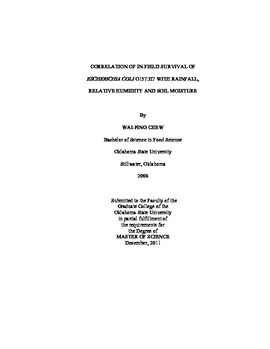| dc.contributor.advisor | McGlynn, William | |
| dc.contributor.author | Chew, Wai Ping | |
| dc.date.accessioned | 2014-04-15T20:12:40Z | |
| dc.date.available | 2014-04-15T20:12:40Z | |
| dc.date.issued | 2011-12-01 | |
| dc.identifier.uri | https://hdl.handle.net/11244/8801 | |
| dc.description.abstract | The objective of the study was to determine possible correlations between selected environmental factors (rainfall, relative humidity, and soil moisture) and the survival of non-pathogenic E.coli O157:H7 in soils amended with inoculated cattle manure and in soils inoculated by direct-spray application of bacterial inoculums. Bacterial transfer onto and survival on spinach grown in inoculated plots was also examined. The in-field study was conducted at the Oklahoma State University Cimarron Valley Research Station, Payne County, Oklahoma. A total of 4 treatments were applied in 20 plots arranged in a randomized complete block design. The treatments employed were: non-inoculated control plots; plots amended with non-inoculated manure; plots amended with inoculated manure; and plots treated by direct-spray application of bacterial inoculums. Soil sampling was conducted on a weekly basis for 7 weeks, and then once in month in January, February, and March 2011. Soil samples were assayed for the presence and surviving numbers of inoculated E.coli O157:H7 cells. Immature spinach leaves were harvested during the growing season (from week 3 to week 7) and analyzed for the presence of E.coli O157:H7 in or on the leaf tissue. The population of inoculated E.coli O157:H7 were observed to decline rapidly in all inoculated plots. From week 0 to week 1, about a 2-log reduction was seen. The population of inoculated cells dropped below the limit of detection by direct plating after 4 weeks for the direct-spray inoculated plots and after 6 weeks for the inoculated-manure plots. Thus, we conclude that manure as a soil amendment may assist in the survival of enteric bacteria. The inoculated bacteria were detectable by enrichment for at least 20 weeks in all inoculated plots. Rainfall was more highly correlated with the survival of the inoculated bacteria than the other weather conditions examined, and a one-week lagged effect was observed. No consistent, strong correlation was seen between soil moisture or relative humidity and the population counts of E. coli O157:H7. No E. coli O157:H7 cells were confirmed present in or on the spinach leaves harvested from the inoculated plots; this may been due to limited leaf sampling. Recommendations for future studies include evaluating additional types of inoculation and soil and leaf sampling techniques.</ | |
| dc.format | application/pdf | |
| dc.language | en_US | |
| dc.publisher | Oklahoma State University | |
| dc.rights | Copyright is held by the author who has granted the Oklahoma State University Library the non-exclusive right to share this material in its institutional repository. Contact Digital Library Services at lib-dls@okstate.edu or 405-744-9161 for the permission policy on the use, reproduction or distribution of this material. | |
| dc.title | Correlation of In-field Survival of Escherichia Coli O157:h7 with Rainfall, Relative Humidity and Soil Moisture | |
| dc.type | text | |
| dc.contributor.committeeMember | Brandenberger, Lynn | |
| dc.contributor.committeeMember | Rayas-Duarte, Patricia | |
| osu.filename | Chew_okstate_0664M_11722.pdf | |
| osu.college | Agricultural Sciences and Natural Resources | |
| osu.accesstype | Open Access | |
| dc.description.department | Department of Animal Science | |
| dc.type.genre | Thesis | |
| dc.subject.keywords | food science | |
